Chapter 2: Manufacturing
1/63
There's no tags or description
Looks like no tags are added yet.
Name | Mastery | Learn | Test | Matching | Spaced |
|---|
No study sessions yet.
64 Terms
WHAT ARE THE STRATEGIES OF THE MOST PROFITABLE COMPANIES IN THE WORLD?
Saudi Aramco is the most profitable company in the world. Other highly profitable companies are Apple and Microsoft. What makes these companies so consistently profitable? These companies have each built a sustainable business model and competitive advantages that allow them to generate strong financial returns over time.
Process design
includes selecting the appropriate technology, sizing the process over time, determining the role of inventory in the process, and
Infrastructure decisions
within operations strategy include the selection of the logic associated with the planning and control systems
Operations and supply chain strategy
Concerned with setting broad polices and plans for using the resources of a firm and must be integrated with corporate strategy
The social impact of the triple bottle line
Concept pertains to fair and beneficial business practices toward labor the community and the region in which a firm conducts its business
Social triple bottom line
Pertains to fair and beneficial business practices toward labor the community and the region in which a firm conducts its business
Cost or price
Forms a company’s strategic operational competitive position in their strategic planning
Economic prosperity
Form is obligated to compensate shareholders who provide capital through stock purchases and other financial instruments via a competitive return on investment
Multifactor input productivity
Output%labor +capital +energy
Sustainability
The ability to meet current resource needs without compromising the ability of future generations to meet their needs.
Triple bottom line
Evaluating the firm against social, economic, and environmental criteria.
Know what a sustainable business strategy is and how it relates to operations and supply chain management.
Strategy should describe how a firm intends to create and sustain value for its current shareholders. By adding sustainability to the concept, we add the requirement to meet these current needs without compromising the ability of future generations to meet their own needs. Shareholders are those individuals or companies that legally own one or more shares of stock in the company. Many companies today have expanded the scope of their strategy to include stakeholders.
Stakeholders are those individuals or organizations that are influenced, either directly or indirectly, by the actions of the firm. This expanded view means that the scope of the firm's strategy must not only focus on the economic viability of its shareholders, but should also consider the environmental and social impact on key stakeholders.
To capture this expanded view, the phrase triple hoffom line has been coined. The triple bottom line, I Exhibit 2.1, considers evaluating the firm against social, economic, and environmental criteria.
Operations and supply chain strategy
The setting of broad policies and plans that will guide the use of the resources needed by the firm to implement its corporate strategy.
Operations effectiveness
Performing activities in a manner that best implements strategic priorities at minimum cost.
Define operations and supply chain strategy.
Operations and supply chain strategy is concerned with setting broad policies and plans for using the resources of a firm and must be integrated with corporate strategy.
Dperations effectivenessi relates to the core business processes needed to run the business.
Competitive Dimensions
Given the choices customers face today, how do they decide which product or service to buy? Different customers are attracted by different attributes. Some customers are interested primarily in the cost of a product or service and, correspondingly, some companies attempt to position themselves to offer the lowest prices. The major competitive dimensions that form the competitive position of a firm are discussed next.
Quality: "Make a Great Product or Deliver a Great Service"
There are two characteristics of a product or service that define quality: design quality and process quality. Design quality relates to the set of features the product or service contains. Obviously, a child's first two-wheel bicycle is of significantly different quality than the bicycle of a world-class cyclist. The use of special aluminum alloys and special lightweight sprockets and chains is important to the performance needs of the advanced cyclist. These two types of bicycles are designed for different customers' needs. The higher-quality cyclist product commands a higher price in the marketplace due to its special features. The goal in establishing the proper level of design quality is to focus on the requirements of the customer. Overdesigned products and services with too many or inappropriate features will be viewed as prohibitively expensive. In comparison, underdesigned products and services will lose customers to products that cost a little more but are perceived by customers as offering greater value.
Process quality, the second characteristic of quality, is critical because it relates directly to the reliability of the product or service. Regardless of whether
the product is a child's first two-wheeler or a bicycle for an international cyclist, customers want products without defects. Thus, the goal of process quality is to produce defect-free products and services. Product and service specifications, given in dimensional tolerances and/or service error rates, define how the product or service is to be made. Adherence to these specifications is critical to ensure the reliability of the product or service as defined by its intended use.
The Notion of Trade-Offs
Central to the concept of operations and supply chain strategy is the notion of operations focus and trade-offs. The underlying logic is that an operation cannot excel simultaneously on all competitive dimensions. Consequently, management has to decide which parameters of performance are critical to the firm's success and then concentrate the resources of the firm on these particular characteristics.
For example, if a company wants to focus on the speed of delivery, it cannot be very flexible in its ability to offer a wide range of products. Similarly, a low-cost strategy is not compatible with either speed of delivery or flexibility. High quality also is viewed as a trade-off to low cost.
A strategic position is not sustainable unless there are compromises with other positions. Trade-offs occur when activities are incompatible so that more of one thing necessitates less of another. An airline can choose to serve meals-adding cost and slowing turnaround time at the gate-or it can choose not to, but it cannot do both without bearing major inefficiencies.
Straddling occurs when a company seeks to match the benefits of a successful position while maintaining its existing position. It adds new features, services, or technologies onto the activities it already performs.
strategic position is not sustainable unless there are compromises with other positions. Trade-offs occur
when activities are incompatible so that more of one thing necessitates less of another. An airline can choose to serve meals-adding cost and slowing turnaround time at the gate-or it can choose not to, but it cannot do both without bearing major inefficiencies.
Straddling
When a firm seeks to match what a competitor is doing by adding new features, services, or technologies to existing activities. This often creates problems if certain trade-offs need to be made.
occurs when a company seeks to match the benefits of a successful position while maintaining its existing position. It adds new features, services, or technologies onto the activities it already performs.
Order Winners and Order Qualifiers: The Marketing-Operations Link
The Terms order winner and order qualifier describe marketing-oriented dimensions that are key to competitive success. Anjorder wing is a criterion that differentiates the products or services of one firm from those of another. Depending on the situation, the order-winning criterion may be the cost of the product (price), product quality and reliability, or any of the other dimensions developed earlier.
An order qualifier is
a screening criterion that permits a firm's products to even be considered as possible candidates for purchase.
Activity system maps such as the one for IKEA show how a company's strategy is delivered through a set of tailored activities.
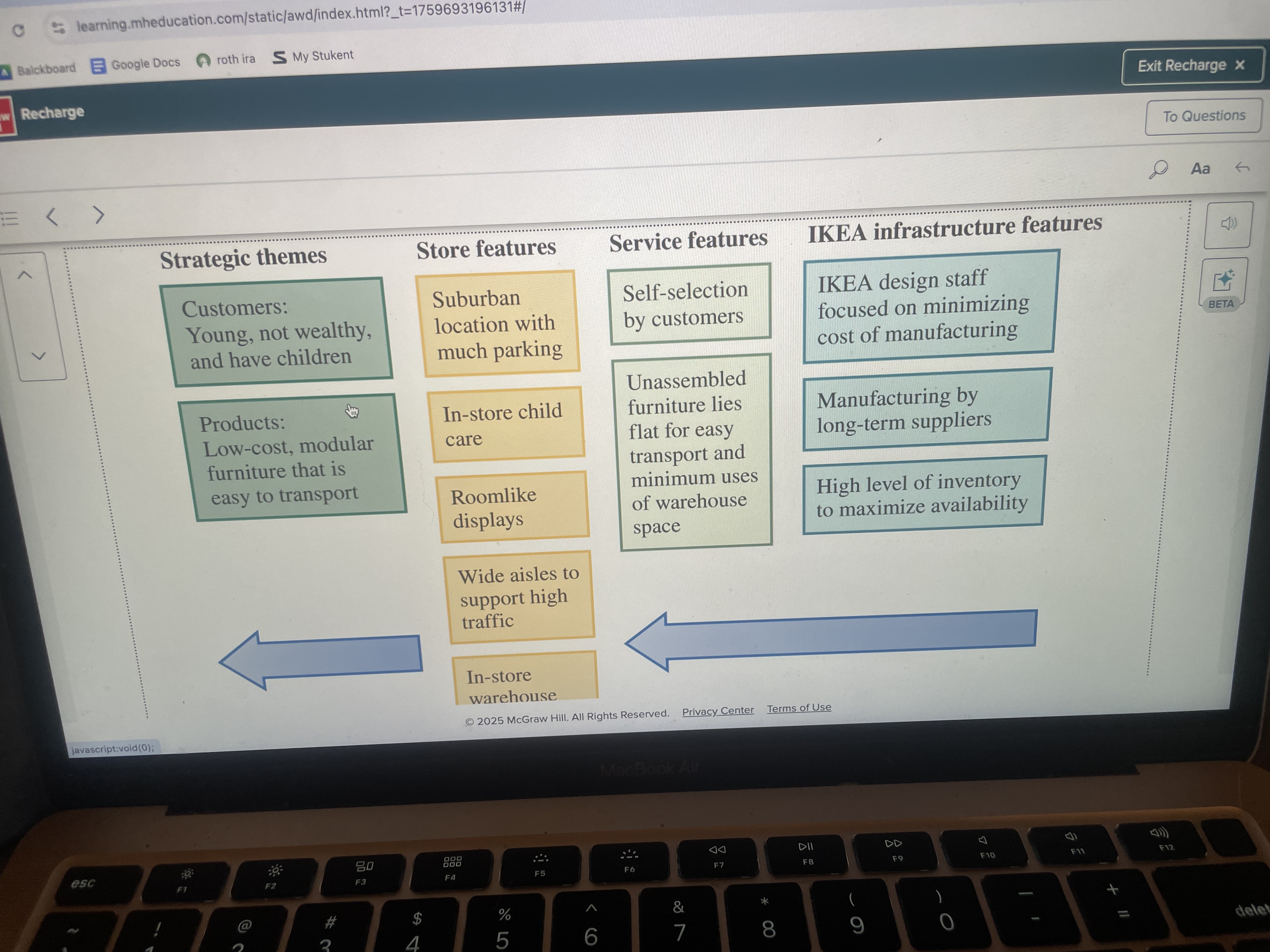
Activity-system maps
Diagrams that show how a company's strategy is delivered through a set of supporting activities.
Supply chain risk
the likelihood of a disruption that would impact the ability of the company to continuously supply products or services. Supply chain disruptions are unplanned and unanticipated events that disrupt the normal flow of goods and materials within a supply chain and expose firms within the supply chain to operational and financial risks. Companies implementing operations and supply chain strategies must consider the risk in their supply chains and develop initiatives to cope with these disruptions and mitigate their impact on the business.
We can categorize risk by viewing the inherent uncertainties related to operations and supply chain management along two dimensions:
supply chain coordination risks that are associated with the day-to-day management of the supply chain, which are normally dealt with using safety stock, safety lead time, overtime, and so on; and
(2)
disruption risks, which are caused by natural or human-made disasters, such as earthquakes, hurricanes, terrorism, and even pandemics.
disruption risks,
which are caused by natural or human-made disasters, such as earthquakes, hurricanes, terrorism, and even pandemics.
supply chain coordination risks
that are associated with the day-to-day management of the supply chain, which are normally dealt with using safety stock, safety lead time, overtime, and so on; and
(2)
Risk Management Framework for Disruption Risks
Identify the sources of potential disruptions. Assessing a type of vulnerability is the first step in the risk management framework. These are highly situation-dependent, but the focus should be on highly unlikely events that would cause a significant disruption to normal operations. Such types of events include natural disasters, capacity failures, infrastructure failures (for example, air traffic systems), terrorists, supplier failures, labor actions, equipment failures, commodity price volatility, and military/civil conflict.
Assess the potential impact of the risk. Here the goal is to quantify the probability and the potential impact of the risk. Depending on the specific incident, this assessment could be based on financial impact, environmental impact, ongoing business viability, brand image/reputation, potential human lives, and so on.
Develop plans to mitigate the risk Specific plans should be developed for the high- and moderate-risk events. These plans are intended to detail options and actions to enhance opportunity and reduce the threats of the risks. There are basically four types of risk-mitigating strategies: avoid, accept, transfer, and limit.
Productivity
a common measure of how well a country, industry, or business unit is using its resources (or factors of production). Since operations and supply chain management focuses on making the best use of the resources available to a firm, productivity measurement is fundamental to understanding operations-related performance. In this section, we define various measures of productivity. Throughout the rest of the book, many other performance measures will be defined as they relate to the material.
Avoid:
Risks should be avoided that have a high probability of both financial loss and damage.
Accept
With some risks, the expenses involved in mitigating the risk is more than the cost of tolerating the risk. In this situation, the risks should be accepted and carefully monitored.
transfer
Risks with a low probability of taking place but would have a large financial impact should be mitigated by being shared or transferred. For example, insurance could be purchases, a partnership forms, multiple sources used, or possibly outsourcing could be done.
Limit
The most common mitigation strategy is risk limitation. Here businesses take some type of action to address the risk and manage the exposure. This involves some level of risk acceptance and avoidance.
Productivity = Outputs / Inputs
To increase productivity, we want to make this ratio of outputs to inputs as large as practical.
Productivity is what we call a relative measure. In other words, to be meaningful, it needs to be compared with something else. For example, what can we learn from the fact that we operate a restaurant and that its productivity last week was 8.4 customers per labor hour? Nothing!
Productivity comparisons can be made in two ways. First, a company can compare itself with similar operations within its industry, or it can use industry data when such data are available (e.g., comparing productivity among the different stores in a franchise). Another approach is to measure productivity over time within the same operation. Here we would compare our productivity in one time period with that in the next.
As L' Exhibit 2.5 shows, productivity may be expressed as partial measures, multifactor measures, or total measures.
partial productivity measure
If we are concerned with the ratio of some output to a single input, we have a partial productivity measure.
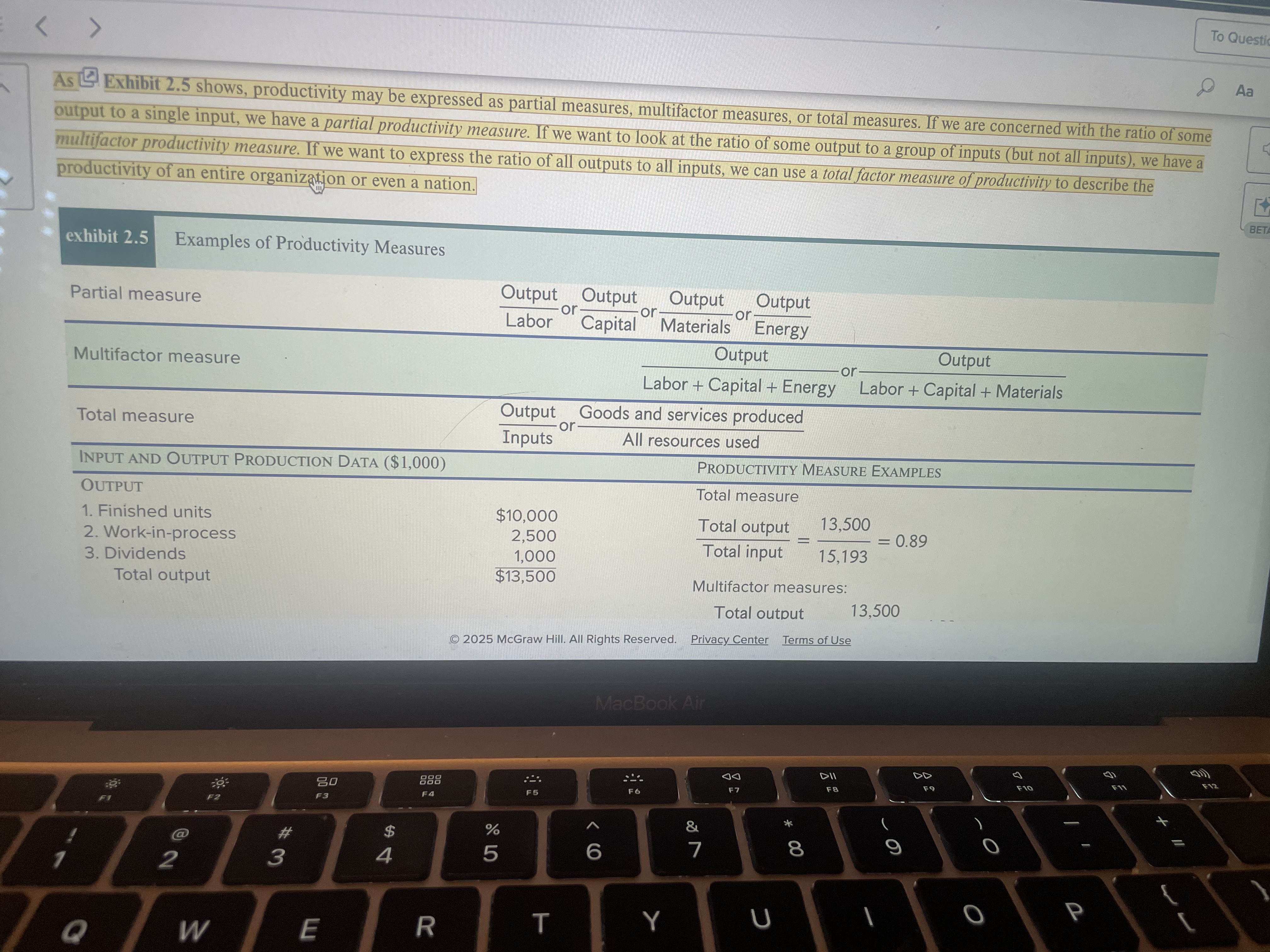
multifactor productivity measure.
If we want to look at the ratio of some output to a group of inputs (but not all inputs), we have a multifactor productivity measure.
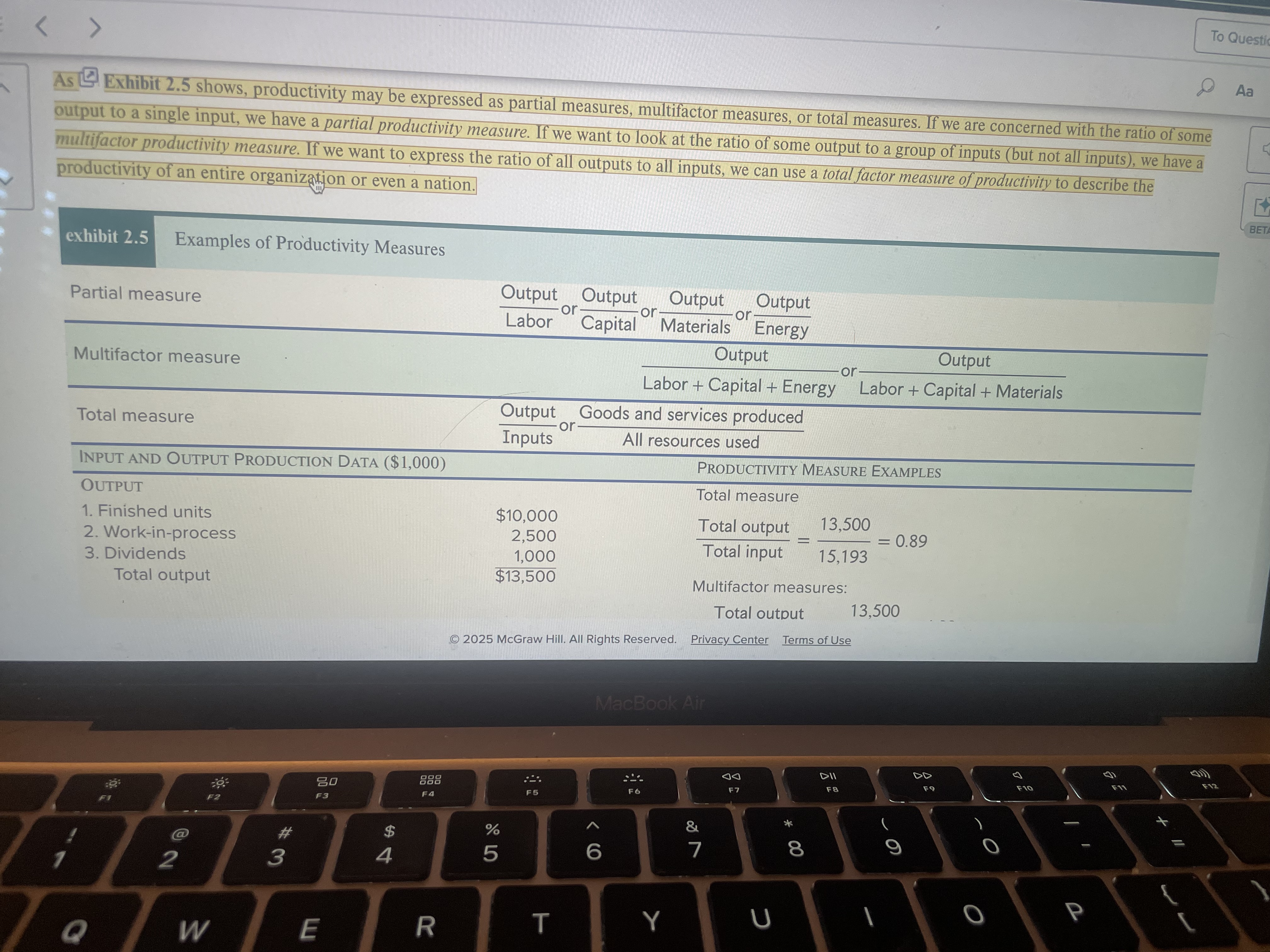
we can use a total factor measure of productivity to describe the productivity of an entire organization or even a nation.
we want to express the ratio of all outputs to all inputs,
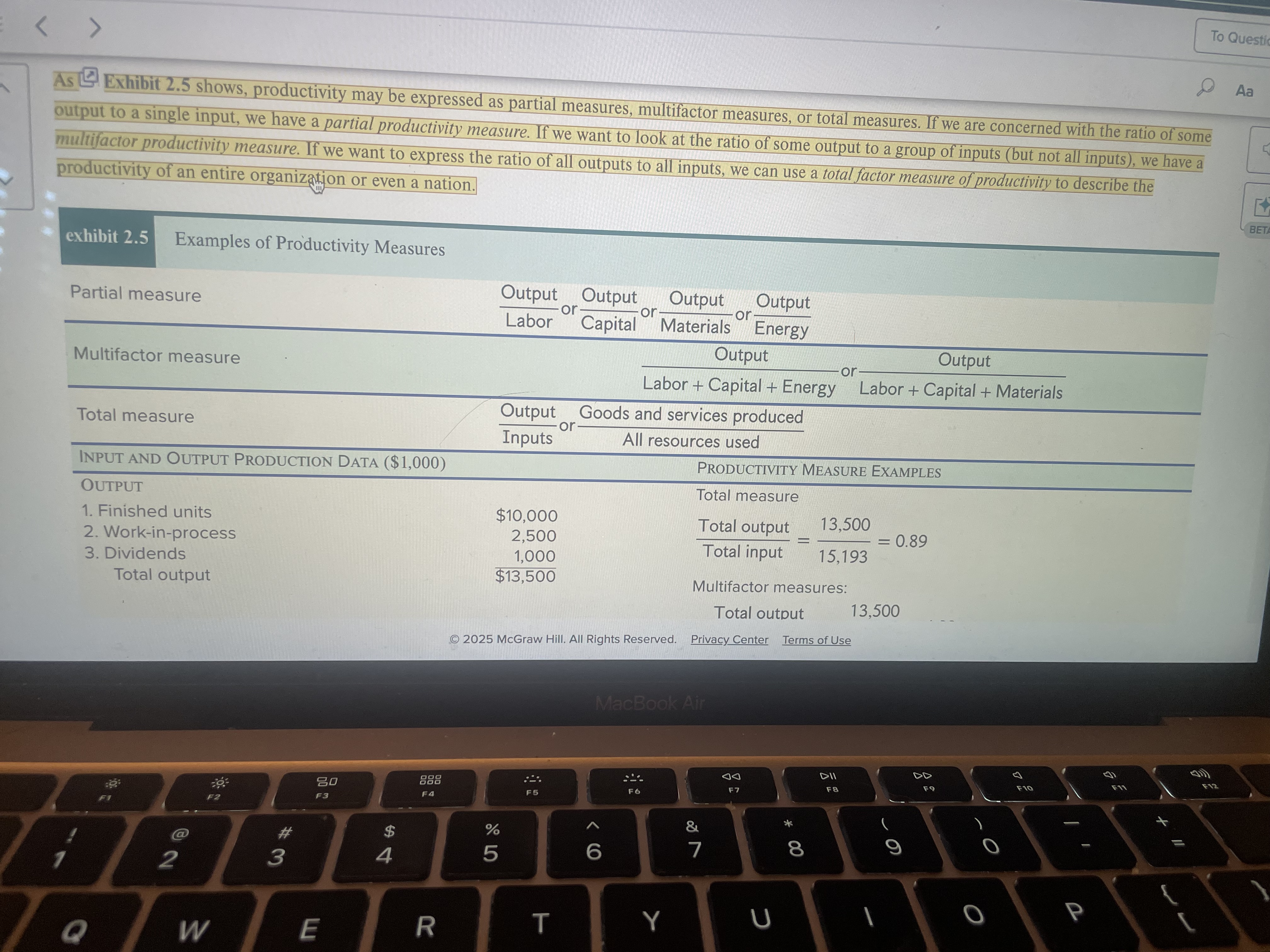
which of the following may be an important product-specific criterion to consider?
Supplier after-sale support.
Decisions that relate to the design of the processes and the
infrastructure needed to support these processes relate to which
OSCM concept?
integrating operations and supply chain strategy with a firm's operational capabilities.
Integrating operations and supply chain strategy with a firm's operations capabilities involves
decisions that relate to the design of the processes and infrastructure needed to support these processes.
Which of the following lists contains only competitive dimensions of a firm discussed in the text?
Cost or price, Triple bottom line, order winners
Delivery speed, delivery reliability, order qualifiers
Cost or price, delivery speed, delivery reliability, new product design
Cost or price, delivery speed, delivery reliability, flexibility and new product introduction speed
Triple bottom line, delivery speed, deliver reliability, supplier after sale support
4.)
Choose the most accurate description in the context of operations and supply chain from the following lists.
Order winners and order qualifiers are two ways of describing market-oriented dimensions of a product.
Order winners differentiates a product or service from another while order qualifiers are built in features.
Order winners are built in features and order qualifiers are necessary features.
Order qualifier is a screening criterion while order winner is a differentiating criterion.
Order winners may have been order qualifiers before.
Order qualifier is a screening criterion while order winner is a differentiating criterion.
In a firm, all other things remaining the same, if the material usage per unit of final product decreases to half of the current usage, then the firm will
double the | |
material | |
productivity and | |
increase the | |
multifactor | |
productivity | |
Everything else being equal, what is the impact on productivity when inputs increase?
It goes down
Productivity = Outputs ÷ Inputs.
Therefore, if the denominator increases while the numerator stays the same, the value of productivity decreases.
When outsourcing integrated circuits (ICs), a communication network provider failure has a high impact. What is the best risk mitigation strategy?
Transfer
When outsourcing integrated circuits (ICs), a supplier quality failure has a moderate impact.
What is the best risk mitigation strategy?
Limit
Competitive dimensions
Cost or price
Quality
Delivery speed
Delivery reliability
Flexibility
Cost or price
Make product or deliver the service cheap
Within every industry, there is usually a segment of the market that buys solely on the basis of low cost. To successfully compete in this niche, a firm must be the low-cost producer, but even this does not always guarantee profitability and success. Products and services sold strictly on the basis of cost are typically commodity-like; in other words, customers cannot distinguish the product or service of one firm from that of another. This segment of the market is frequently very large, and many companies are lured by the potential for significant profits, which they associate with the large unit volumes. As a consequence, however, competition in this segment is fierce-and the failure rate high. After all, there can be only one low-cost producer, who usually establishes the selling price in the market.
Price, however, is not the only basis on which a firm can compete (although many economists appear to assume it is!). Other companies, such as BMW, seek to attract people who want higher quality-in terms of performance, appearance, or features-than what is available in competing products and services, even though it means a higher price.
Quality
Make a great product or deliver a great service
Delivery Speed:
"Make the Product or Deliver the Service Quickly"
In some markets, a firm's ability to deliver more quickly than its competitors is critical. A company that can offer an onsite repair service in only 1 or 2 hours has a significant advantage over a competing firm that guarantees service only within 24 hours.
Delivery reliability
"Deliver It When Promised"
This dimension relates to the firm's ability to supply the product or service on or before a promised delivery due date. For an automobile manufacturer, it is very important that its supplier of tires provide the needed quantity and types for each day's car production. If the tires needed for a particular car are not available when the car reaches the point on the assembly line where the tires are installed, the whole assembly line may have to be shut down until they arrive. For a service firm such as FedEx, delivery reliability is the cornerstone of its strategy.
Flexibility
"Change It"
Flexibility, from a strategic perspective, refers to the ability of a company to offer a wide variety of products to its customers. An important element of this ability to offer different products is the time required for a company to develop a new product and to convert its processes to offer the new product.
Other Product-Specific Criteria:
Support it
Technical liaison and support. A supplier may be expected to provide technical assistance for product development, particularly during the early stages of design and manufacturing.
Page 30
Ability to meet a launch date. A firm may be required to coordinate with other firms on a complex project. In such cases, manufacturing may take place while development work is still being completed. Coordinating work between firms and having them work simultaneously on a project will reduce the total time required to complete the project.
Supplier after-sales support. An important competitive dimension may be the ability of a firm to support its product after the sale. This involves the availability of replacement parts and, possibly, the modification of older, existing products, bringing them up to new performance levels. The speed of response to these after-sale needs is often important as well.
Environmental impact. A dimension related to criteria such as carbon dioxide emissions, the use of nonrenewable resources, and other factors that relate to sustainability.
Lean inventory practices
relate to having minimum inventory levels and just-in-time resupply based on short term need.
Distribution hub
is when inventory in concentrated in a centralized or "hub" location and then moved to secondarv distribution points.
Sole sourcing
is th practice of procuring producya
and parts that is strategically important to the firm from only a single provider.
Planning strategy
is a
Pag
BETA
process just like making a product or delivering a service. The process involves a set of activities that are repeated at different intervals over time. Just as products are made over and over, the strategy planning activities are repeated.
Initiatives
are the major steps that need to be taken to drive success in the firm. Many of these initiatives are repeated from year to year, such as the updating of existing product designs and the operation of manufacturing plants in different regions of the world.
Social responsibility.
Fair and beneficial business practices towards labor, community and the region it operates.
Forbid child labor, safe work environment, fair salaries, sustainable work hours.
Giving back to the community through health care, education, special programs.
Environmental stewardship.
Protect the environment to the greatest extent possible.
Cause no harm at a minimum.
Manage ecological footprint by managing resource consumption and reducing waste.
Assess and act on cradle-to-grave cost.
Economic prosperity.
Meet firm's obligation to the investors through competitive ROl.
Promote growth and long term value.
Beyond profit, provide lasting economic benefit to society.
Operations and Supply Chain Risks
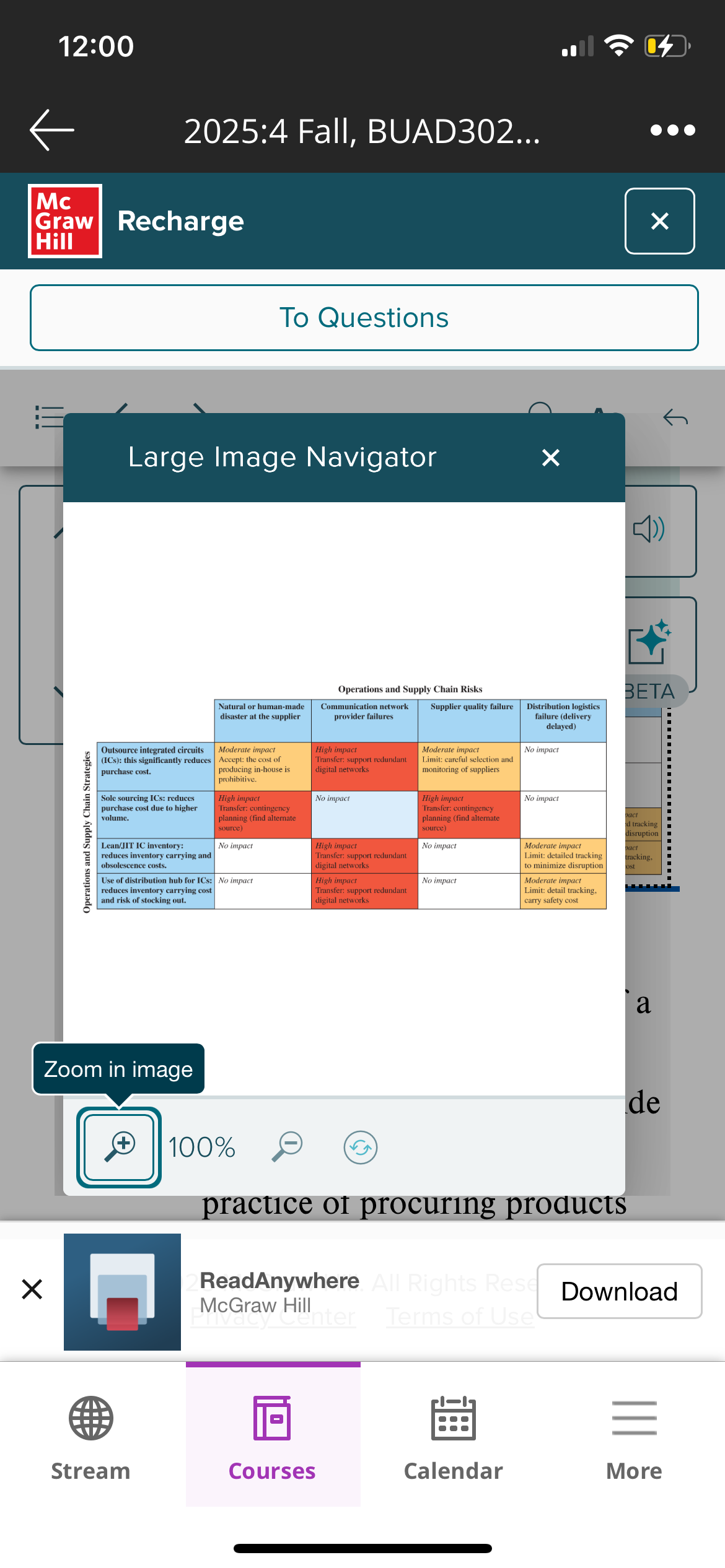
Natural or human-madE disaster at the suppler
Outsource integrated circuits
moderate impact
Accept: